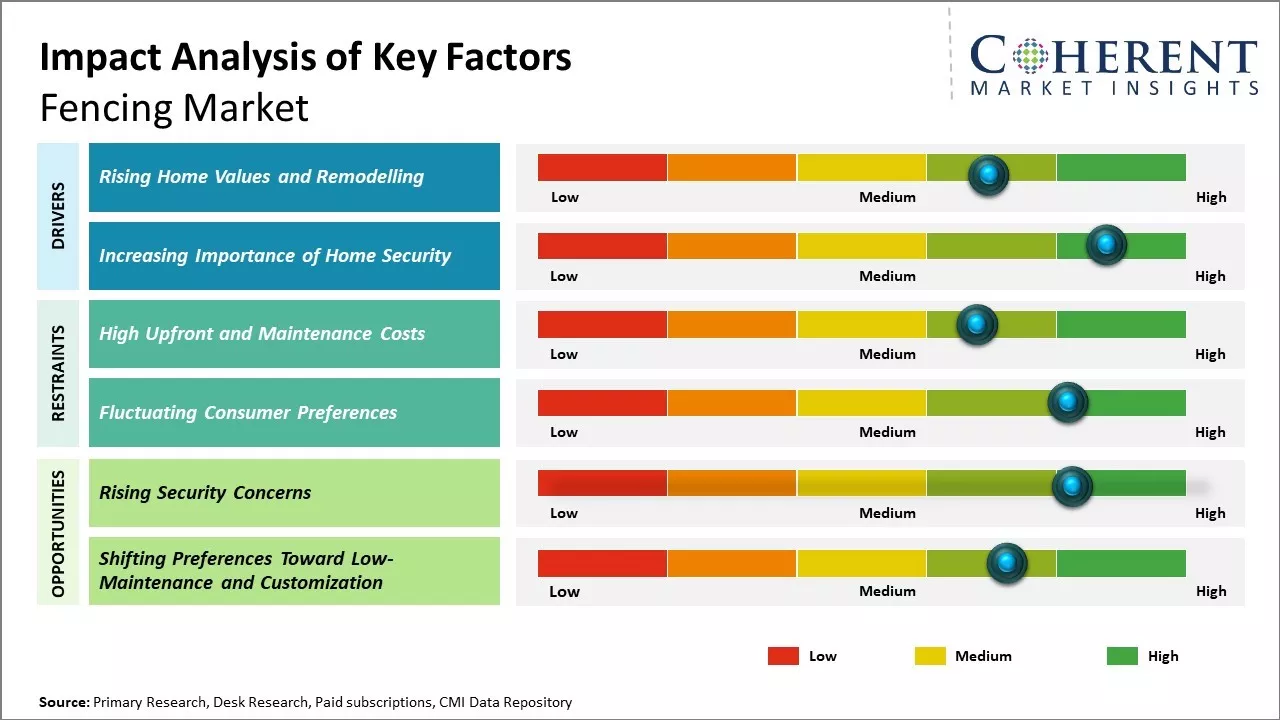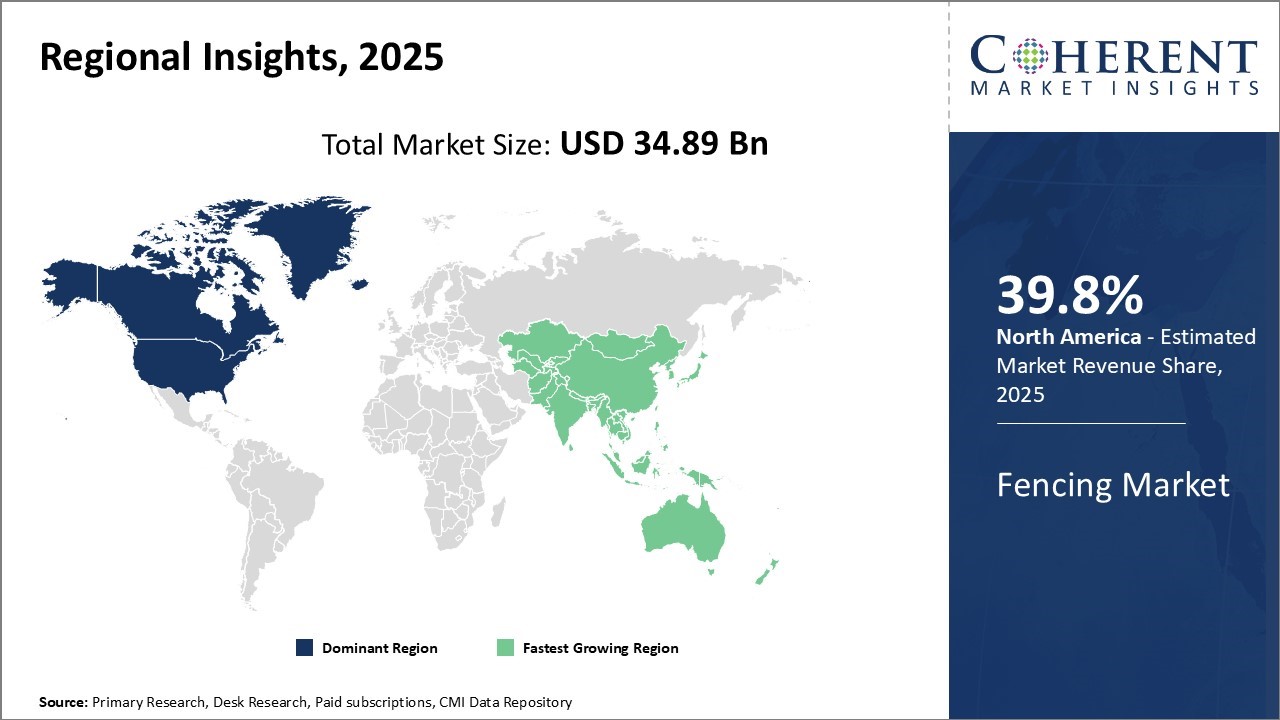The Fencing Market is estimated to be valued at USD 34.89 Bn in 2025 and is expected to reach USD 52.49 Bn by 2032, exhibiting a compound annual growth rate (CAGR) of 6.0% from 2025 to 2032.

To learn more about this report, Download Free Sample
The global Fencing Market is experiencing steady growth, driven by rising concerns over security, property demarcation, and aesthetic enhancement. Metal fencing dominates the market due to its strength, durability, and low maintenance. Residential applications lead demand, fuelled by increasing home construction and renovation activities. Technological innovations in materials and customizable designs are enhancing product appeal.
|
Current Event |
Description and its impact |
|
Product Innovations and Regulatory Shifts |
|
|
Strategic Partnerships and Production Expansion |
|
|
Policy Trends and Market Compliance Impact |
|
Uncover macros and micros vetted on 75+ parameters: Get instant access to report
The pricing structure of the global fencing market is shaped by a combination of material costs, labour charges, regional demand, and customization trends. In 2025, metal fencing particularly steel and aluminium remains the most expensive segment due to raw material volatility, manufacturing complexity, and longer lifespan. Vinyl and composite fencing also command premium prices, driven by rising consumer demand for low-maintenance, weather-resistant solutions with aesthetic appeal.
Labour costs significantly affect overall pricing, especially in North America and Europe, where installation charges are high due to skilled labour requirements and regulatory compliance. Additionally, customized and smart fencing systems equipped with sensors or automation features further elevate costs.
Conversely, wood and chain-link fencing continue to offer more affordable options, particularly in price-sensitive markets across Asia and Latin America. However, fluctuations in timber prices and supply chain disruptions may influence cost consistency.
Overall, pricing remains competitive, with innovation, material innovation, and regional construction trends dictating market dynamics.
The fencing market is undergoing a transformative shift fuelled by rapid technological advancements that enhance security, durability, and customization. Smart fencing systems are emerging as a major trend, incorporating sensors, surveillance cameras, motion detectors, and automated gates. These technologies are particularly gaining traction in commercial, industrial, and high-end residential sectors, where perimeter security is a top priority.
Innovations in materials are also shaping the market composite fencing, vinyl coatings, and powder-coated metals offer longer lifespan, resistance to corrosion, and minimal maintenance compared to traditional wood or untreated metal. Additionally, 3D modelling and computer-aided design (CAD) tools are enabling manufacturers and consumers to visualize and customize fencing solutions with precision.
Automation in installation processes and modular fencing systems are reducing labour time and cost. As sustainability becomes a priority, recyclable and eco-friendly materials are increasingly integrated. These advancements are redefining consumer expectations and expanding application possibilities across sectors.
Consumer feedback in the fencing market reflects a growing demand for durable, aesthetically appealing, and low-maintenance fencing solutions. Many homeowners’ express satisfaction with modern materials like vinyl, composite wood, and powder-coated metal for their longevity and visual appeal. Additionally, the rise of smart fencing solutions has been well-received, particularly in urban and suburban areas where security and automation are key concerns.
However, unmet demand persists in several areas. A common concern is the high initial cost of advanced or customized fencing systems, which deters budget-conscious consumers. Others report limited availability of eco-friendly or recycled material options, especially in emerging markets. There is also a gap in skilled installation services in rural regions, affecting timely project completion and quality assurance.
Furthermore, customers increasingly seek multi-functional fencing offering security, noise reduction, and privacy highlighting the need for innovation that combines utility, sustainability, and affordability in future market offerings.
As home values continue to appreciate year after year in many markets across the country, homeowners feel more comfortable investing larger amounts of money into upgrades and renovations for their homes. Fencing is one of the most common outdoor projects that homeowners tackle when they want to increase their property's curb appeal and security.
Replacing or installing new fencing has become a very popular remodelling and renovation project. Contractors report steady demand from homeowners’ association for community-wide fencing replacements. This driver bodes well for continued demand for fencing for both residential and light commercial applications.
In July 2025, Atlas officially rebranded as Atlas Fence Company to strengthen its focus on residential and commercial fencing services. This move is aimed at meeting rising demand with specialized expertise, faster project delivery, and enhanced quality standards within Central Texas.
With growing concerns over safety and security, having proper fencing has become a priority for many homeowners. News reports of break-ins, theft and property damage have contributed to rising fears. Homeowners seek reassurance that comes with fences that clearly mark the boundaries of their property and deter intruders.
Fencing companies have responded with products customized for residential security needs including reinforced panels, anti-climbing electric fences, and smart locks for automated gates. This concern for safety enhances demand and drives homeowners to fortify and enclose their properties.
For instance, in August 2023, the U.S. Representative Pramila Jayapal, D-Seattle, spent over US$ 45,000 on home security in 2023, using campaign funds, as reported by Federal Election Commission records. As the leader of the Congressional Progressive Caucus, Jayapal is among many congressional leaders who have increased their spending on personal security. This trend has grown since the January 6, 2021, Capitol riot and the heightened polarization in the political climate.
In April 2025, the chief executive of Barclays cautioned against removing Britain's post‑crisis "ring‑fencing" rules, arguing that doing so could undermine financial stability and expose banks to market shocks.
Crime rates, vandalism, and even worries about privacy are prompting many to secure their properties. A well-placed fence acts as a deterrent and creates a physical barrier, providing peace of mind. With a growing emphasis on “defensible space" concepts, property owners are creating clear boundaries to deter unwanted access.
The Metal Fencing segment is expected to dominate the global fencing market, accounting for an estimated 55.9% of the total market share in 2025. This dominance stems from the superior durability, strength, and versatility of metal fences across residential, commercial, and industrial settings. Materials such as steel, aluminium, and wrought iron are widely adopted due to their low maintenance requirements and high resistance to weather and physical impact.
Advancements in anti-corrosive coatings, powder finishes, and galvanized treatments are extending product lifespan while enhancing visual appeal. The rising emphasis on perimeter security—particularly in urban developments, public infrastructure, and industrial zones—is further driving demand for robust fencing materials. Metal fencing is also gaining traction in high-security facilities due to its compatibility with automation and surveillance systems.
In the Residential Fencing Market with Installation Cost becoming an increasingly important factor, metal fences offer a compelling value proposition through long-term durability and minimal upkeep expenses, making them a cost-efficient choice for homeowners. As innovation continues in modular designs and eco-friendly manufacturing processes, the metal fencing segment is poised to sustain its leadership through 2025 and beyond.
The Residential segment is projected to hold the largest share of the fencing market, contributing approximately 34.1% in 2025. This growth is fuelled by rising investments in housing development, renovations, and growing concerns around home security and personal privacy. Fencing in residential applications serves both functional and decorative purposes ranging from boundary demarcation and safety for children and pets to landscape enhancement.
The surge in home improvement trends, particularly in suburban and semi-urban regions, is encouraging homeowners to adopt customized and visually appealing fencing solutions. Additionally, increased awareness of property protection and aesthetic value is pushing the adoption of fencing in single-family homes, gated communities, and villas.
With continued expansion in real estate, rising disposable income, and the popularity of DIY-friendly fencing products, the residential application segment is expected to remain the primary revenue generator in the global fencing market through the forecast period.

To learn more about this report, Download Free Sample
North America is poised to lead the global fencing market, commanding an estimated 39.8% share in 2025. This regional dominance is driven by sustained construction activity, heightened security concerns, and stringent government regulations related to property boundaries and zoning compliance.
The U.S. remains the primary growth engine, supported by a robust housing market, increasing investments in public infrastructure, and a growing preference for aesthetically pleasing yet secure fencing options.
Demand for residential and commercial fencing has surged due to rising homeownership, remodeling trends, and enhanced awareness of property protection. A key driver within this is the Privacy Fencing Market for Backyards, where consumers are increasingly seeking visually appealing, durable, and low-maintenance solutions to enhance outdoor living spaces while ensuring privacy and security.
Additionally, the market is witnessing growing interest in high-quality, customized fencing solutions made from durable materials like vinyl, metal, and composite wood. Established regional manufacturers, combined with advancements in automated and smart fencing technologies, are fueling innovation and accessibility.
As urbanization accelerates and perimeter security becomes a priority, North America is expected to maintain its leadership, shaping the future of fencing design, installation, and application.
The United States stands as the dominant force in the global fencing market, significantly contributing to North America’s projected 39.8% market share in 2025. This leadership stems from a robust housing sector, continuous infrastructure development, and a growing emphasis on residential and commercial property security. The country is witnessing rising demand for durable and aesthetically appealing fencing solutions in suburban and urban regions alike.
The U.S. market benefits from the presence of established fencing manufacturers offering a wide range of materials including metal, vinyl, and composite options. Innovation in smart and automated fencing systems, along with customization trends, further accelerates adoption across residential, industrial, and agricultural applications. Stringent local zoning laws and homeowner association regulations also contribute to the regular installation and maintenance of boundary structures.
With high consumer spending on home improvement and a proactive approach to property protection, the United States is expected to maintain its leadership in the global fencing industry.
Canada plays a key supporting role in the North American fencing market, driven by rising investments in residential construction, urban development, and property safety enhancements. The country has seen a steady increase in demand for fencing solutions across suburban housing projects, commercial properties, and public infrastructure.
Canadian consumers are increasingly opting for metal and vinyl fencing due to their longevity and low maintenance. Additionally, the growing popularity of decorative and eco-friendly materials reflects the market’s evolving preferences. Provinces like Ontario and British Columbia are witnessing a surge in fence installations due to population growth and expanding residential neighborhoods.
| Report Coverage | Details | ||
|---|---|---|---|
| Base Year: | 2024 | Market Size in 2025: | USD 34.89 Bn |
| Historical Data for: | 2020 To 2024 | Forecast Period: | 2025 To 2032 |
| Forecast Period 2025 to 2032 CAGR: | 6.0% | 2032 Value Projection: | USD 52.49 Bn |
| Geographies covered: |
|
||
| Segments covered: |
|
||
| Companies covered: |
Allied Tube & Conduit, Ameristar Fence Products Incorporated, Associated Materials LLC, Bekaert, Betafence NV, CertainTeed Corporation, Gregory Industries, Inc., Jerith Manufacturing Company Inc., Long Fence Company Inc., Ply Gem Holdings Inc., Poly Vinyl Creations Inc., and The American Fence Company |
||
| Growth Drivers: |
|
||
| Restraints & Challenges: |
|
||
Uncover macros and micros vetted on 75+ parameters: Get instant access to report
Share
Share
About Author
Ramprasad Bhute is a Senior Research Consultant with over 6 years of experience in market research and business consulting. He manages consulting and market research projects centered on go-to-market strategy, opportunity analysis, competitive landscape, and market size estimation and forecasting. He also advises clients on identifying and targeting absolute opportunities to penetrate untapped markets.
Missing comfort of reading report in your local language? Find your preferred language :
Transform your Strategy with Exclusive Trending Reports :
Frequently Asked Questions
Joining thousands of companies around the world committed to making the Excellent Business Solutions.
View All Our Clients